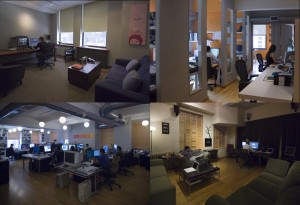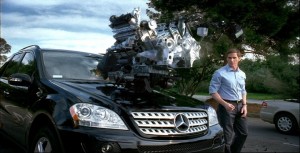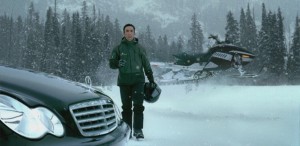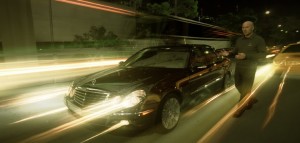The days of work simply walking in the door are long gone and it is key that the vfx facility brings something strong to the table. In the end, if the house adds creative value to spot, it’s likely that the agency creatives will return to work with the artists again and again…like Merkely did at rhinofx when they approached them about a Mercedes spot.
Work on the Mercedes campaign for Merkely began with only one spot and the crew at rhinofx had no idea it would involve a campaign of spots. “When we were first approached, there was no master plan, ” says founder Vico Sharabani. “We never thought this would be the first of 14 spots of a new campaign. Our first thoughts were these were great boards with tricky effects that required creating its own signature.”

They were approached by Merkely early in the stages of development of the first commercial. Even before the clients at Mercedes were approached with the creative concept, the boards were run by the artists at rhinofx to ensure that the agency could correctly present them with respect to time and budget. This kind of involvement is critical, as the agency could present boards to the client that either couldn’t be accomplished or could be finished at a price tag far above the budget. And the artists at rhinofx get to show they’re up to the task…and then some.
While the facility has gone to great lengths to ensure that they are adding to the creative on spots, it wasn’t always as primary a focus at the New York City based company. They opened in 1998, but the founders feel the genesis was August 2000 when they built their 3D department and had new management.Â
“There was a tremendous shortage of effects studios in New York as opposed to finishing facilities,” says rhinofx partner and artist Vico Sharabani. “New York was perceived to be a facility town capable of demos and product replacement where the emphasis was the hourly rate, what machine, what software and what hardware,” he says. “We re-positioned the studio in 2000 when we expanded with new management and additional talent. From that moment on it was always about the talent emphasizing our position as a studio” The vfx house now has 40 full time employees and works on commercials and feature films with additional business in branded entertainment and video game work.
For several of the Mercedes spots, rhinofx was presented with the boards prior to the directors discussing them with the agency — in effect, the agency was relying on their relationship with the post house to help them through the production. “Most of the boards we spent some time with the production and creative departments discussing, thinking, suggesting, prior to the bidding process,” says Sharabani.
 Once the job was awarded, rhinofx remained involved until delivery. “This creative trifecta — “Agency, Director and rhinofx†— made the process efficient and fun. All of the directors invited us to be a part of the brainstorming from the early stages of story boarding,”  During the year of working on the 14 spot campaign, there wasn’t really any structure to the prcoess other than “here’s a board, let’s talk about it, get your input, and then take it from there,†he says.
Once the job was awarded, rhinofx remained involved until delivery. “This creative trifecta — “Agency, Director and rhinofx†— made the process efficient and fun. All of the directors invited us to be a part of the brainstorming from the early stages of story boarding,”  During the year of working on the 14 spot campaign, there wasn’t really any structure to the prcoess other than “here’s a board, let’s talk about it, get your input, and then take it from there,†he says.
The Mercedes campaign is based on reality so the creative challenge was to recreate reality in an accurate manner without the visual effects becoming overwhelming. For this reason, Tinker and Highway where the challenging creatively for rhinofx due to the emphasis on the design phase. For Highway, there where many interpretations from the creatives involved, so there was a necessary design phase to line up everybody’s vision. “The danger in a ‘frozen moment’ verbal description conjures up Matrix references,” says Sharabani. “If anything, it was more like how do we do this so people don’t think Matrix when looking at Mercedes.” For Tinker there was an exploration process while designing the animation to go through all the possible ways to slice the engine. In the end, the creatives felt the transformation was the most exciting so they went with that approach.
The Spots
View “Blowout” QuickTime
View “Highway” QuickTime
View “Jiggle” QuickTime
View “Pipe” QuickTime
View “Snowmobile” QuickTime
Before/After Breakdown of “Snowmobile”
View “Snowmobile” vfx BreakdownWe spoke with Sharabani about the campaign and some of the individual spots.Â
fxg: The spots in the campaign had different directors — what was it like to work on multiple spots in the same campaign with different visions?
Sharabani: We were lucky to work with very talented directors: Arni & Kinski – HSI, Snori Brothers – Smuggler, Nico Beyer – Crossroads, Laurent Briet – Little Minx, and Peter Lang – Pictures in a Row.
It was interesting working with different directors, because at the end of the day, it was always a frozen moment, actually it became a ‘freezing’ moment as everything is slowed down, not stopped. All of the directors were very respectful of this being a visual effect job.
Part of collaboration is not just figuring out what needs to be done, but supporting each others requirements. They gave us what we needed and we gave them what they needed. At the end of the day, the different visions were more the result of different boards, different situations and how best to tell that story, whether its a rolling pipe, a blowing tire, streaking lights, or an animating engine.
All of the spots required the same amount of collaboration and attention to detail. Some spots may look easier then others, but generally, they require the same amount of focus.
Â

fxg: What did you do on-set to ensure that you had everything you needed? With 3D tracking, did you survey things or take measurements?Â
Sharabani: We covered the basic stuff, most backgrounds were tracked using the details in the shot, so unless needed, we avoid unnecessary tracking markers. HDRI environment maps were used for CG intensive spots such as Tinker, Highway and Jiggle.
Â
If you limit directors on the set for VFX reasons, the shots appear too safe. ‘Snowmobile’ is a good example for letting the directors work freely. Shot in severe weather conditions using a steady cam, there’s not much you can do on set without slowing down production. So we just placed a minimal number of tracking markers in the scenes and shot clean plates.
Â
Â
fxg: What was the post process on the spots? Did you work in 16-bit half or 32-bit float?
Â
Sharabani: The pipeline eveolved depending upon the job:
— 8Bit NTSC: Blowout, Jiggle (first batch in the campaign)
— 10bit DPX: Highway, the nighttime spot, used 10bit DPX files to control better light details and overall color correct in Shake
— 0pen EXR for Tinker due to combining multiple 3D passes
— D5-HD for Snowmobile
Â
fxg: Were they finished in HD? Were effects only done in HD?Â
Â
Sharabani: The first spot to be finished in HD was Snowmobile. The intention is to continue with HD in the future. In most cases CGI effects are rendered in HD resolution and downsized for higher quality.
Â

fxg: What equipment/software was used and why?Â
Sharabani: Flame proved to be an effective solution for most of the spots that came with an extremely short 2 week post schedule. It gave us opportunities to utilize Flame in innovative ways to solve problems that would have required much more resources and time. Certain spots like Tinker or Highway, utilizing DPX and OpenEXR files were composited using desktop solutions like Fusion and Shake.
Maya is our primary 3D package running on Linux. Renderman compliant AIR and Mental Ray is used for rendering. We also utilize proprietary software for various aspects of production from 3d asset management pipeline to rendering.
fxg: How do you make the decision on what software and equipment to use?
Â
Sharabani: In most cases creative leads determine the workflow and approach based upon the technical and creative demands of the project along with time constraints.
Â

fxg: What was interesting about the spots as to the approach in post (and production)?
Â
Sharabani: Highway required us to develop a specific look based upon motion blur. This approach mimics what would happen if it were done for real optically. The hero car was match-moved in every shot to create CGI reflections and unique night look. Color grading and compositing was done in Shake.
Snowmobile was completed solely in Inferno. 3D tracking, particle snow in Action, and background replacement and landscape reconstruction.  We used every trick from Particle expressions to the Camera Dad expression, and developed a camera tracking technique for shots that could not be solved by either boujou or Flame. We decided to art direct the environment and replace all the backgrounds. So we rotoscoped the talent and cars and used outtakes to rebuild a nicer landscape.  The spot was completed in HD and took 10 days to finish. rhinofx Inferno Artist John Budion presented this spot at NAB Autodesk booth.
Â
Tinker was the most complex effect for the campaign. It required a longer schedule and a bigger crew. The 3D engine was created using Maya with an exceptional team of artists led by Arman Matin, rhinofx CG director. CAD data was imported from Mercedes in Germany and processed to fit our 3d pipeline. We developed software to handle multiple resolutions of the heavy model so that artists could work transparently with low res models that would get rendered as high res at render time. This increased efficiency as animators could work more interactively.
HDR based lighting with AIR was used to generate the photorealistic renders. A short schedule of six weeks for a project like this required modeling, animation, shading, texturing and lighting to happen all at once. Our custom assets management and versioning software allowed lighters to setup shot lighting while shader artists were working on shaders, animators and modelers modifying the data structure and changing models. Scripts were used to propogate lighting and render passes across all shots. Compositing was done on Fusion, and Flame used for final touch ups.
Â
fxg: From an artistic standpoint, what was the most challenging aspect?
Sharabani: I would say Highway was most challenging artistically due to the need to design an unique look, and create a wide variety of 3D elements. Highway is one of the those spots where no one other then the artist can fully appreciate what went into this. For example, we started with dpx scans and color corrected with director Laurent Briet using Shake.
Â
fxg: What was groundbreaking for you in doing the spots? Any new techniques you were able to pull out that had been in development?
Sharabani: The Camera tracking approach in ‘Snowmobile’ was innovative. A few shots could have not be solved by any software. We had tried to guesstimate the camera moves and we developed the following technique:
1. Assuming a 2D track of a foreground element is the mirror of the camera movement. In other words, a foreground element moving right to left, is most likely caused by a camera dolly left to right.
2. Assuming a 2D track of a far background element is a result of a pan and tilt. We used these track data to control the camera translation (foreground track) and the camera point of interest (background track)
Â
It was very rewarding to complete the task so quickly while developing something new.
Highway utilized a technique we were developing for our feature film project Perfect Stranger. We used super sub frame motion blur algorithm along with HDR data to create the streak look.
Â
fxg: What were the challenges on the latest spot?
Sharabani: Massive data, short timeline, smimultaneous overlapping artist workflow. Besides technical challenges, from a creative standpoint we had to figure out how to unfold the engine in various aesthetically pleasing juxtapositions to demonstrate some of its inner workings while avoiding intersections and collisions. This required a lot of trial and error in the animation phase.
Rendering a few million polygons using HDRI and global illumination was also very time consuming. We figured out many innovative techniques to optimize rendering times and ended up with 8 to 10 hour render times per frame.
Â
fxg: How do you manage agency/client approvals on such vfx-heavy spots?
 Â
Sharabani: In spots like these the clients are accustomed to a slow start ramping to a rapid end. We walk them through the expected process, discuss expectations and guide them through approvals of rough comps, wireframe or shaded animation, low res rendering, etc. They realize that each day towards the end of the project will bring in progressively rapid improvements to the visuals and prepare their clients accordingly. It is very important for us to guide our clients through the entire process and manage expectations at various stages. After all the intention of both the agency and us is to provide the best visuals and they trust our process on how to reach that goal.
fxg: I imagine you had to work with a number of different editors during the capmaign…how did that go?
Sharabani: Each editor has their style and great relationships were established with the editors on this campaign. We have worked with all on additional projects due to the great experience. (Editors and houses include Steve Bell from Cosmo street, Josh and Andre from Bug Editorial, The Whitehouse, Jump Editorial.
fxg: Â What is your software/equipment base?
Â
Sharabani: Maya is our primary 3D software. Compositing is done using Inferno/Flame, while Fusion is used as our desktop compositing solution. Linux based servers, workstations and render boxes are utilized along with Macs and PCs.
fxg: How do you manage growth in this industry where technology is developing so rapidly?
Sharabani: Shifting our investment towards talent rather than technology has worked well for us. After all, talent grows over time and absorbs newer technology as it is developed.
Â
